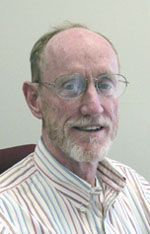California’s East Bay — the collection of towns, cities, and suburbs across the Bay Bridge from San Francisco — has a lot to boast about. There’s the perpetually great weather, enlightened inhabitants, and a halfway decent, if in my opinion overpriced, public transit system in the form of BART. Yet despite BART’s 43 stations spanning 95 miles, most folks in the area find they need a car, too.
 Sherman LewisBut one man thinks his town, Hayward — or at least a part of it — can make the leap to automobile-free. “I want to live a lifestyle that’s less dependent on cars,” says Sherman Lewis, a retired poli-sci professor at Cal State East Bay and president of the Hayward Area Planning Association since 1978. But, he admits, he’s chosen a relatively difficult way to achieve it, “by trying find 950 other families who want to live the same way.”
Sherman LewisBut one man thinks his town, Hayward — or at least a part of it — can make the leap to automobile-free. “I want to live a lifestyle that’s less dependent on cars,” says Sherman Lewis, a retired poli-sci professor at Cal State East Bay and president of the Hayward Area Planning Association since 1978. But, he admits, he’s chosen a relatively difficult way to achieve it, “by trying find 950 other families who want to live the same way.”
Lewis has developed plans for Quarry Village, a 1,000-unit development about a mile from the Hayward BART station and a short skip from the Cal State campus and downtown Hayward. It includes townhouses, condos, walking paths, shuttle buses to the rail … and no garages. It would fill 22 acres on a former rock quarry (hence the name) currently owned by Caltrans, the California DOT; the land is not yet for sale, but Lewis says the agency is supportive of his redevelopment vision. The residences will be officially affordable, at least by Hayward’s definition: studios to six-bedrooms between $250,000 and $650,000. Lewis believes the larger units will appeal to telecommuters, who can use the extra bedrooms as offices.
 Today a quarry, tomorrow a car-free revolution?QuarryVillage.comInside the development, residents would be able to walk to basic amenities — a restaurant or two, a well-stocked grocery store. For other needs, they could take an on-site shuttle to BART, use the shared or rental car services that would be available, or, if they really want, rent one of the 100 or so parking spots along the perimeter of the neighborhood. Those spots would be auctioned off, starting at perhaps $125 a month, to help subsidize the shuttle service. No one need fear being judged for not giving up his or her car, Lewis assures. “They’re going to be congratulated, ” he says,” because their money will go to pay for everyone else’s bus.”
Today a quarry, tomorrow a car-free revolution?QuarryVillage.comInside the development, residents would be able to walk to basic amenities — a restaurant or two, a well-stocked grocery store. For other needs, they could take an on-site shuttle to BART, use the shared or rental car services that would be available, or, if they really want, rent one of the 100 or so parking spots along the perimeter of the neighborhood. Those spots would be auctioned off, starting at perhaps $125 a month, to help subsidize the shuttle service. No one need fear being judged for not giving up his or her car, Lewis assures. “They’re going to be congratulated, ” he says,” because their money will go to pay for everyone else’s bus.”
The Quarry Village vision is inspired in part by the Vauban development in Freiburg, Germany, a 6,000-resident suburb where parking is limited to the perimeter and a space goes for $40,000. Some seventy percent of Vauban-ers don’t own a car, and by all accounts they seem to have adjusted quite easily.
But that’s Europe. Are Americans — some of whom say their car represents them more than their friends of clothes — ready for the car-free experience?
Well, maybe. Car-sharing, it was reported last week, is on the rise, with city policies and real estate developments encouraging the practice. (I find ZipCar, at $120 per weekend day here in New York, to be prohibitively expensive, but perhaps I’m spoiled by my bicycle and my $2 subway). Quebec-based CommunAuto asserts that every shared car knocks eight off the road — that’s about 1,800 fewer miles driven per person each year.
So the political climate is ripe for Quarry Village, and perhaps the mindset of many Americans, still stinging from our brief foray into $4 per gallon gas, has properly adjusted. “We have more than 100 people [ready] to sign up to buy these units when they become available,” says Lewis.
But when will that be? At the end of May, the Hayward Planning Commission gave the thumbs up to new zoning, permitting higher density and less parking, and Lewis expects the city council to overwhelmingly approve SMU zoning — sustainable mixed-use — at the end of June, which Lewis says was created with Quarry Village in mind.
 If you lived here, you’d be ooh-ing now.QuarryVillage.com“The city council is unanimously supportive, but all of us are concerned about getting investors and selling units fast enough,” says Lewis. That’s right, they’re still lacking one key component: the money to actually create the neighborhood, despite plenty of interest and excitement. The tagline displayed prominently on the Quarry Village website sums up the current state of the project: “If you’ll come, we can build it.”
If you lived here, you’d be ooh-ing now.QuarryVillage.com“The city council is unanimously supportive, but all of us are concerned about getting investors and selling units fast enough,” says Lewis. That’s right, they’re still lacking one key component: the money to actually create the neighborhood, despite plenty of interest and excitement. The tagline displayed prominently on the Quarry Village website sums up the current state of the project: “If you’ll come, we can build it.”


